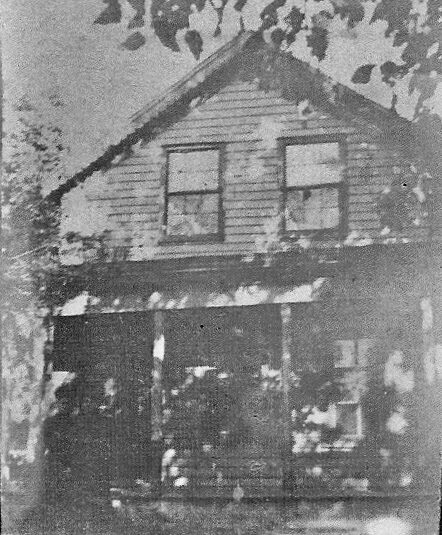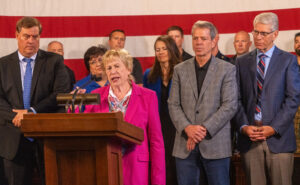5:45
News Story
Underground Railroad site in Falls City recognized by National Park Service
A barn behind the home of David and Ann Dorrington served as a temporary refuge for dozens of escaping slaves
LINCOLN — There was a terrifying annual chore for Robert Nelson during his growing-up years in Falls City.
Just before Memorial Day, he and a cousin had to scrub clean a massive, stone mausoleum that contained the burial vaults of his great-great-great-great-grandparents, David and Ann Dorrington.
Their resting places were in crypts, down a set of deep stairs where stink bugs, dust and mold had accumulated.

“It was spooky,” Nelson said. “The smell was probably mold and mildew, but if you’re a kid, you think it’s the corpses.”
But curiosity eventually got the best of the former columnist for the Omaha World-Herald, now a freelance writer based in Virginia.
His grandmother had spoken of famed abolitionist John Brown staying with the Dorringtons in the period around 1856-59. But he wanted to know more about these people who built such an imposing structure, with its stained-glass windows and church-like pulpit.
A story of bravery and guile
The journalist’s search added rich detail and documentation to an amazing story of bravery and guile associated with the Underground Railroad in his hometown.
At great personal risk, the Dorringtons provided shelter for dozens of escaped slaves during the tense, pre-Civil War clashes between pro-slavery forces and abolitionists along the border between the then-Nebraska Territory and Kansas. It was known as the “bleeding Kansas” period, because of the raids and killings in places such as Lawrence.
(The Dorringtons) were two patriots among dozens who chose to build a town on this prairie hill all the while working to disrupt and dissolve the institution of slavery they loathed.
– freelance writer Robert Nelson
His research also led to Nelson write an extensive application to recognize the site of the Dorringtons’ home and barn as part of the National Park Service’s National Underground Railroad “Network to Freedom” program.
On Friday evening, a ceremony was held on the main street of the southeast Nebraska city. A bronze plaque, citing the work of the Dorringtons, was unveiled in a program held in conjunction with Falls City’s annual Christmas parade.
Among 700 Network to Freedom sites
The Dorrington House and Barn joins more than 700 other sites, facilities and programs recognized by the Network to Freedom program, which seeks to recognize freedom seekers and those who helped them. There are 14 such sites in Nebraska.
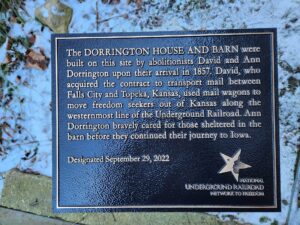
“It’s a really cool story,” Nelson said. “And one that had never been fit together with the bleeding Kansas story.”
The Dorringtons, he said, were “two patriots among dozens” who build a town “all the while working to disrupt and dissolve the institution of slavery they loathed.”
Falls City, his research confirmed, was a key stop for slaves fleeing slave states like Missouri and avoiding pro-slavery militias in Kansas as they made their way northward to freedom. It was also a stopping-off point for abolitionists before crossing the border.
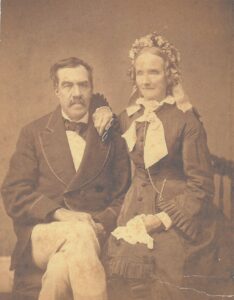
(Courtesy of Robert Nelson)
David and Ann Dorrington built a home in Falls City in 1857, the year the city was founded. One of the founders was James Henry Lane, who became a leader in the free state movement in Kansas, which was then a violent battleground between pro-slavery and abolitionist forces.
‘Abolitionist hole’
By 1859, the town had already become notorious as a “heavily armed harbor for those escaping slavery,” Nelson said.
The new settlement was branded as an “abolitionist hole” by the pro-slavery newspaper editor J. Sterling Morton, best known as the founder of Arbor Day. He called it “the celebrated town founded by Jim Lane and peopled by him with a scurvy horde of rapscallions….”
David Dorrington obtained the federal contract to haul mail from Rulo to Topeka, Kansas, a hotbed of free state and abolitionist activity. The route went through Falls City, and the work, which also included two sons as drivers, provided the ideal means to ferry escaped slaves.
Mail wagons protected
Impeding the mail was a federal crime, so the mail wagon, with a secret compartment to conceal runaways, could pass without being stopped by bounty hunters and pro-slavery militia.
The route he took became known as the “Lane Trail,” so named after James Lane because it avoided pro-slavery forces stationed to the east and because settlers along the route were mostly sympathetic to the frightened freedom seekers.
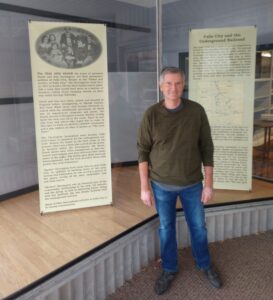
In Falls City, escaping slaves took refuge in a barn behind the Dorringtons’ house.
David Dorrington, as a federal mail contractor, took an oath not to violate federal laws, which forbid sheltering runaway slaves, so even in later years, he didn’t reveal the family’s activities. But his wife wasn’t under such restrictions, and she would sneak food to those sheltering in the barn, sometimes at great risk.
One of the Dorringtons’ daughters, Annie Dorrington Reavis, gave an account of her parents’ activities in a story in the Lincoln Sunday Star in 1922. She said they felt sorry for the escaped slaves who were “being hunted just like wild animals,” and when caught, severely beaten or killed.
Hayloft by day
The slaves, she said, hid in the hayloft of the Dorrington barn during the day, then slipped away at night, sometimes “under a wagon load of corn.”
“My father did not dare to go to the barn at all, for he was being watched closely,” the daughter told the newspaper, “but my mother, who was one of the bravest women I ever knew, would take hot coffee and bread and butter to those negroes after midnight, without the slightest bit of light to guide her. There were some pretty narrow escapes sometimes.”
The Network to Freedom plaque will be installed at the Collections Museum on Stone Street in Falls City. The museum, located in the former Falter Clothing Store, is on the site of the Dorrington home, which was torn down after a devastating fire in 1877 destroyed several other wooden buildings along the main street.
Storefront display
Nelson said that during a visit this spring to Falls City, he noticed the Dorrington display at the Collections Museum and decided it was time to seek greater recognition for the story.
It led him through the files of newspapers, including the Falls City Journal, and to the archives of the Kansas Historical Society. Another aid was Barry Jurgensen, a former teacher in Arlington who is now regional manager of the Network to Freedom program.
Jurgensen said it’s important to recognize such stories because many local residents “do not realize they walk in the same area as these heroes.”
Nelson said History Nebraska may publish his story of the Dorringtons in an upcoming edition of its magazine. And, he said, there’s possibly enough material for a book about that turbulent period of U.S. history.
This is how he put it in an address read at Friday’s ceremony:
“Falls City’s story is unique in this state, rare in this country … a study in courage triumphing over oppression.”
“(It is) vitally instructive for a fuller understanding of a dark period when our best and worst instincts battled for control of this nation.”
SUPPORT NEWS YOU TRUST.
Our stories may be republished online or in print under Creative Commons license CC BY-NC-ND 4.0. We ask that you edit only for style or to shorten, provide proper attribution and link to our website. AP and Getty images may not be republished. Please see our republishing guidelines for use of any other photos and graphics.

